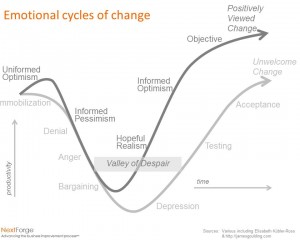 I have a client who is an avid outdoorsman. He often waxes poetically about his kayaking in the Rocky Mountain streams near his cabin- “as long as the water isn’t too high”- and mountain climbing in west Texas. Occasionally, he leaves right after work to get a jump on yet another weekend climbing adventure. His hands are appropriately callused to support all of his outdoor interests and quests. So, looking back it is no surprise he drifted up to the front of the room to talk after a leadership team’s discussion about several “management tools”.
I have a client who is an avid outdoorsman. He often waxes poetically about his kayaking in the Rocky Mountain streams near his cabin- “as long as the water isn’t too high”- and mountain climbing in west Texas. Occasionally, he leaves right after work to get a jump on yet another weekend climbing adventure. His hands are appropriately callused to support all of his outdoor interests and quests. So, looking back it is no surprise he drifted up to the front of the room to talk after a leadership team’s discussion about several “management tools”.
“You know I use this analogy all the time,” he said, referencing the cycle of change. “I tell [my staff] that as you cross the valley below and on much of the climb up, you often cannot see the summit- you just have to believe.”
Change is hard.
Hard for the organization. Kotter’s research indicates 70% of change initiatives fail1.
Hard for the individuals. Holmes and Rahe have researched individuals’ stress, including ranking of different types of stress. Further, they have correlated individuals’ levels of stress back to physical illness- large amounts of stress increases your risk of illness. While it is no surprise there is stress related to business change, the amount of stress for a “business readjustment” is ranked just below “pregnancy” and a bit above “death of a close friend.”2
 How to think about the cycle of change
How to think about the cycle of change
We need to think about the individuals. We need to lead and manage the organization, by changing behaviors of the individual. One mental model we can borrow is one from those facing even more difficult life change- those facing the diagnosis of cancer. Elisabeth Kübler-Ross introduced the idea of “five stages of grief” in her book On Death and Dying based on her work with terminally ill patients3. Change leadership practitioners have been using this same frame to describe the stages of change the organization is going through at least since the early 1990’s. While there are several variations on Kübler-Ross’ initial work4, they seem to support a similar sequence of steps. And we, as change leadership practitioners, must be ready to lead and manage not only for individuals and our teams, but in support of the organization’s change.
What we should do to go faster and to increase our chance of success
The first step toward improvement is recognition of this 5-step pattern in the cycle of change. Next, we need to understand organizations change one person at a time.
If we are successful in helping better manage individuals, and thereby the organization, through better understanding of these steps, we can expect to improve on the 30% success rate in achieving our business outcome and on accomplishing the targeted outcome in less time. The following is illustrative of the type of change management thinking change leaders need to put into leading and managing change throughout the 5 steps of the emotional cycles of change.
|
Steps in Emotional |
To better manage the core team, consider… |
|
Uniformed Optimism |
Direct enthusiasm toward initial steps- |
|
Informed Pessimism |
Focus on the approach and milestones- |
|
Hopeful Realism |
Revisit the overall business objective- |
|
Informed Optimism |
Celebrate incremental progress- |
|
Objective Achievement |
Ensure broad-based engagement- |
End Notes and References
1 “The 8-Step Process for Leading Change”, Kotter International’s website [internet] [cited June 17, 2013] Available from http://www.kotterinternational.com/our-principles/changesteps/changesteps.
2 Wikipedia, “Holmes and Rahe stress scale”, [internet] [cited June 17, 2013] Available from http://en.wikipedia.org/wiki/Holmes_and_Rahe_stress_scale.
3 Wikipedia, “Kübler-Ross model”, [internet] [cited June 17, 2013] Available from http://en.wikipedia.org/wiki/K%C3%BCbler-Ross_model.
4 Elsass, Paul, “Stages of Acceptance in Cancer”, 10.2.2010 post on LIVESTRONG.com, [internet] [cited June 17, 2013] Available http://www.livestrong.com/article/267917-stages-of-acceptance-in-cancer/. Elsass notes the National Cancer Institute recommends three stages of grief from Dr. Roberta Temes’ Living with an empty chair- a guide through grief, including Stage I) Shock & numbness (mechanical functioning); Stage II) Disorganization (hard to plan for the future); and, Stage III) Reorganization (acceptance of the new without the old).


One Response